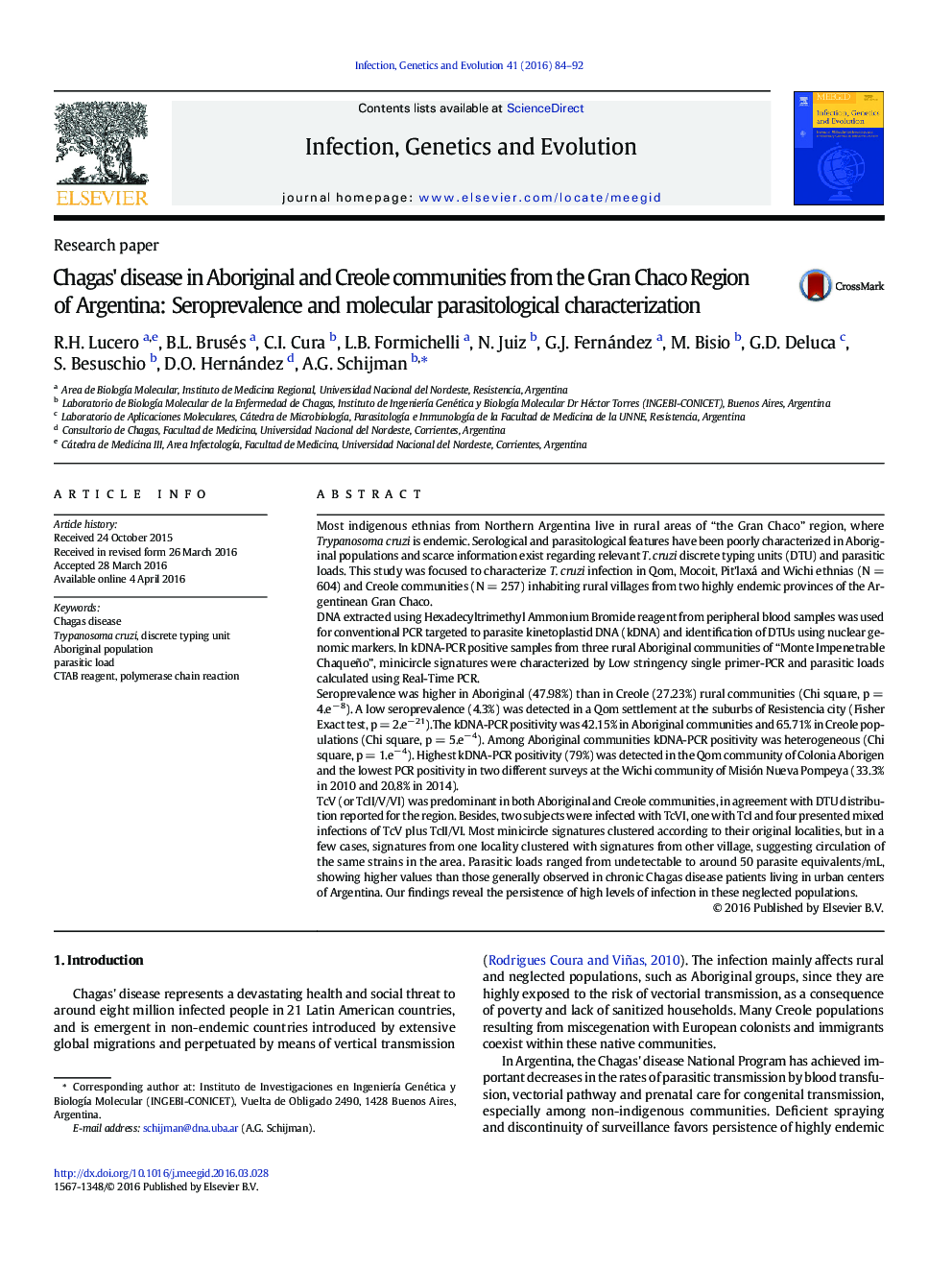| کد مقاله | کد نشریه | سال انتشار | مقاله انگلیسی | نسخه تمام متن |
|---|---|---|---|---|
| 2822900 | 1570162 | 2016 | 9 صفحه PDF | دانلود رایگان |
• Infection by Trypanosoma cruzi was searched in Aboriginal and Creole rural villages from two endemic provinces of Northern Argentina.
• Seroprevalence was high in Aboriginal and Creole rural communities.
• PCR targeted to minicircle sequences show high variability in PCR positivity among different Aboriginal communities.
• Some patients showed higher parasitic loads than expected at the chronic stage, suggesting the occurrence of re-infections.
• Discrete typing units were identified directly from blood samples; TcV prevailed followed by TcVI, TcI and mixed infections.
Most indigenous ethnias from Northern Argentina live in rural areas of “the Gran Chaco” region, where Trypanosoma cruzi is endemic. Serological and parasitological features have been poorly characterized in Aboriginal populations and scarce information exist regarding relevant T. cruzi discrete typing units (DTU) and parasitic loads. This study was focused to characterize T. cruzi infection in Qom, Mocoit, Pit'laxá and Wichi ethnias (N = 604) and Creole communities (N = 257) inhabiting rural villages from two highly endemic provinces of the Argentinean Gran Chaco.DNA extracted using Hexadecyltrimethyl Ammonium Bromide reagent from peripheral blood samples was used for conventional PCR targeted to parasite kinetoplastid DNA (kDNA) and identification of DTUs using nuclear genomic markers. In kDNA-PCR positive samples from three rural Aboriginal communities of “Monte Impenetrable Chaqueño”, minicircle signatures were characterized by Low stringency single primer-PCR and parasitic loads calculated using Real-Time PCR.Seroprevalence was higher in Aboriginal (47.98%) than in Creole (27.23%) rural communities (Chi square, p = 4.e− 8). A low seroprevalence (4.3%) was detected in a Qom settlement at the suburbs of Resistencia city (Fisher Exact test, p = 2.e− 21).The kDNA-PCR positivity was 42.15% in Aboriginal communities and 65.71% in Creole populations (Chi square, p = 5.e− 4). Among Aboriginal communities kDNA-PCR positivity was heterogeneous (Chi square, p = 1.e− 4). Highest kDNA-PCR positivity (79%) was detected in the Qom community of Colonia Aborigen and the lowest PCR positivity in two different surveys at the Wichi community of Misión Nueva Pompeya (33.3% in 2010 and 20.8% in 2014).TcV (or TcII/V/VI) was predominant in both Aboriginal and Creole communities, in agreement with DTU distribution reported for the region. Besides, two subjects were infected with TcVI, one with TcI and four presented mixed infections of TcV plus TcII/VI. Most minicircle signatures clustered according to their original localities, but in a few cases, signatures from one locality clustered with signatures from other village, suggesting circulation of the same strains in the area. Parasitic loads ranged from undetectable to around 50 parasite equivalents/mL, showing higher values than those generally observed in chronic Chagas disease patients living in urban centers of Argentina. Our findings reveal the persistence of high levels of infection in these neglected populations.
Figure optionsDownload as PowerPoint slide
Journal: Infection, Genetics and Evolution - Volume 41, July 2016, Pages 84–92
